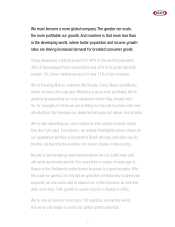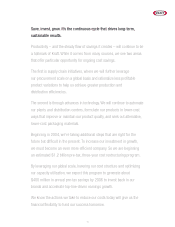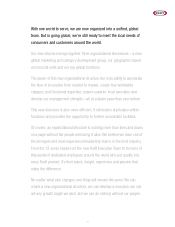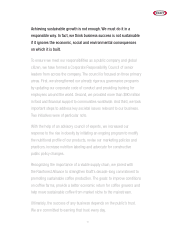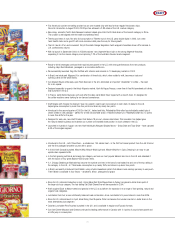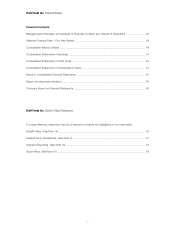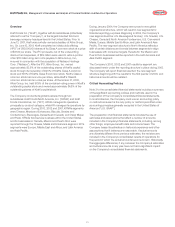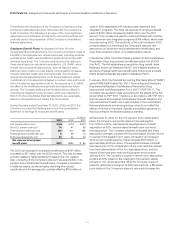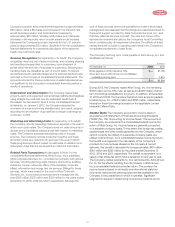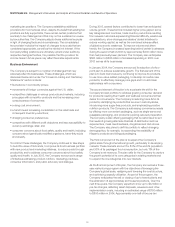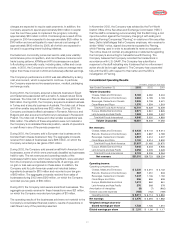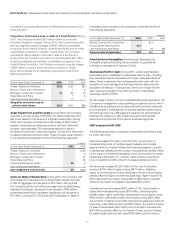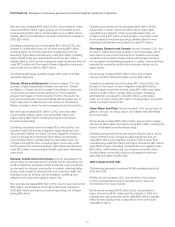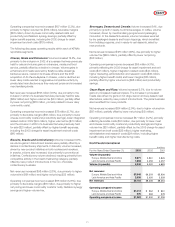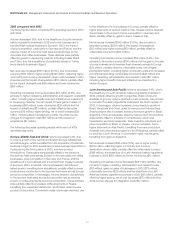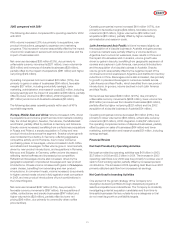Kraft 2003 Annual Report Download - page 25
Download and view the complete annual report
Please find page 25 of the 2003 Kraft annual report below. You can navigate through the pages in the report by either clicking on the pages listed below, or by using the keyword search tool below to find specific information within the annual report.
Overview
Kraft Foods Inc. (“Kraft”), together with its subsidiaries (collectively
referred to as the “Company”), is the largest branded food and
beverage company headquartered in the United States. Prior to
June 13, 2001, Kraft was a wholly-owned subsidiary of Altria Group,
Inc. On June 13, 2001, Kraft completed an initial public offering
(“IPO”) of 280,000,000 shares of its Class A common stock at a price
of $31.00 per share. The IPO proceeds, net of the underwriting
discount and expenses, of $8.4 billion were used to retire a portion
of an $11.0 billion long-term note payable to Altria Group, Inc.,
incurred in connection with the acquisition of Nabisco Holdings
Corp. (“Nabisco”). After the IPO, Altria Group, Inc. owned
approximately 83.9% of the outstanding shares of Kraft’s capital
stock through its ownership of 49.5% of Kraft’s Class A common
stock and 100% of Kraft’s Class B common stock. Kraft’s Class A
common stock has one vote per share, while Kraft’s Class B
common stock has ten votes per share. At December 31, 2003,
Altria Group, Inc. held 97.9% of the combined voting power of Kraft’s
outstanding capital stock and owned approximately 84.6% of the
outstanding shares of Kraft’s capital stock.
The Company conducts its global business through two
subsidiaries: Kraft Foods North America, Inc. (“KFNA”) and Kraft
Foods International, Inc. (“KFI”). KFNA manages its operations
principally by product category, while KFI manages its operations by
geographic region. During 2003, 2002 and 2001, KFNA’s segments
were Cheese, Meals and Enhancers; Biscuits, Snacks and
Confectionery; Beverages, Desserts and Cereals; and Oscar Mayer
and Pizza. KFNA’s food service business within the United States
and its businesses in Canada, Mexico and Puerto Rico were
reported through the Cheese, Meals and Enhancers segment. KFI’s
segments were Europe, Middle East and Africa; and Latin America
and Asia Pacific.
During January 2004, the Company announced a new global
organizational structure, which will result in new segments for
financial reporting purposes. Beginning in 2004, the Company’s
new segments will be U.S. Beverages & Grocery; U.S. Snacks; U.S.
Cheese, Canada & North America Foodservice; U.S. Convenient
Meals; Europe, Middle East & Africa; and Latin America & Asia
Pacific. The new segment structure in North America reflects a
shift of certain divisions and brands between segments to align
businesses with consumer targets. Results for the Mexico and
Puerto Rico businesses will be reported in the Latin America and
Asia Pacific segment.
The Company’s 2003, 2002 and 2001 results by segment are
discussed herein under the reporting structure in place during 2003.
The Company will report financial results in the new segment
structure beginning with the results for the first quarter of 2004, and
historical amounts will be restated.
Critical Accounting Policies
Note 2 to the consolidated financial statements includes a summary
of the significant accounting policies and methods used in the
preparation of the Company’s consolidated financial statements.
In most instances, the Company must use an accounting policy
or method because it is the only policy or method permitted under
accounting principles generally accepted in the United States of
America (“U.S. GAAP”).
The preparation of all financial statements includes the use of
estimates and assumptions that affect a number of amounts
included in the Company’s financial statements, including, among
other things, employee benefit costs and income taxes. The
Company bases its estimates on historical experience and other
assumptions that it believes are reasonable. If actual amounts
are ultimately different from previous estimates, the revisions are
included in the Company’s consolidated results of operations for
the period in which the actual amounts become known. Historically,
the aggregate differences, if any, between the Company’s estimates
and actual amounts in any year have not had a significant impact
on the Company’s consolidated financial statements.
23
Kraft Foods Inc. Management’s Discussion and Analysis of Financial Condition and Results of Operations


